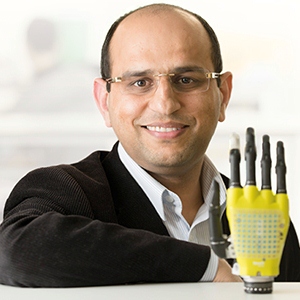A March 23, 2017 news item on Nanowerk highlights research that could put feeling into a prosthetic limb,
A new way of harnessing the sun’s rays to power ‘synthetic skin’ could help to create advanced prosthetic limbs capable of returning the sense of touch to amputees.
Engineers from the University of Glasgow, who have previously developed an ‘electronic skin’ covering for prosthetic hands made from graphene, have found a way to use some of graphene’s remarkable physical properties to use energy from the sun to power the skin.
Graphene is a highly flexible form of graphite which, despite being just a single atom thick, is stronger than steel, electrically conductive, and transparent. It is graphene’s optical transparency, which allows around 98% of the light which strikes its surface to pass directly through it, which makes it ideal for gathering energy from the sun to generate power.
A March 23, 2017 University of Glasgow press release, which originated the news item, details more about the research,
Dr Ravinder DahiyaA new research paper, published today in the journal Advanced Functional Materials, describes how Dr Dahiya and colleagues from his Bendable Electronics and Sensing Technologies (BEST) group have integrated power-generating photovoltaic cells into their electronic skin for the first time.
Dr Dahiya, from the University of Glasgow’s School of Engineering, said: “Human skin is an incredibly complex system capable of detecting pressure, temperature and texture through an array of neural sensors which carry signals from the skin to the brain.
“My colleagues and I have already made significant steps in creating prosthetic prototypes which integrate synthetic skin and are capable of making very sensitive pressure measurements. Those measurements mean the prosthetic hand is capable of performing challenging tasks like properly gripping soft materials, which other prosthetics can struggle with. We are also using innovative 3D printing strategies to build more affordable sensitive prosthetic limbs, including the formation of a very active student club called ‘Helping Hands’.
“Skin capable of touch sensitivity also opens the possibility of creating robots capable of making better decisions about human safety. A robot working on a construction line, for example, is much less likely to accidentally injure a human if it can feel that a person has unexpectedly entered their area of movement and stop before an injury can occur.”
The new skin requires just 20 nanowatts of power per square centimetre, which is easily met even by the poorest-quality photovoltaic cells currently available on the market. And although currently energy generated by the skin’s photovoltaic cells cannot be stored, the team are already looking into ways to divert unused energy into batteries, allowing the energy to be used as and when it is required.
Dr Dahiya added: “The other next step for us is to further develop the power-generation technology which underpins this research and use it to power the motors which drive the prosthetic hand itself. This could allow the creation of an entirely energy-autonomous prosthetic limb.
“We’ve already made some encouraging progress in this direction and we’re looking forward to presenting those results soon. We are also exploring the possibility of building on these exciting results to develop wearable systems for affordable healthcare. In this direction, recently we also got small funds from Scottish Funding Council.”
For more information about this advance and others in the field of prosthetics you may want to check out Megan Scudellari’s March 30, 2017 article for the IEEE’s (Institute of Electrical and Electronics Engineers) Spectrum (Note: Links have been removed),
Cochlear implants can restore hearing to individuals with some types of hearing loss. Retinal implants are now on the market to restore sight to the blind. But there are no commercially available prosthetics that restore a sense of touch to those who have lost a limb.
Several products are in development, including this haptic system at Case Western Reserve University, which would enable upper-limb prosthetic users to, say, pluck a grape off a stem or pull a potato chip out of a bag. It sounds simple, but such tasks are virtually impossible without a sense of touch and pressure.
Now, a team at the University of Glasgow that previously developed a flexible ‘electronic skin’ capable of making sensitive pressure measurements, has figured out how to power their skin with sunlight. …
Here’s a link to and a citation for the paper,
Energy-Autonomous, Flexible, and Transparent Tactile Skin by Carlos García Núñez, William Taube Navaraj, Emre O. Polat and Ravinder Dahiya. Advanced Functional Materials DOI: 10.1002/adfm.201606287 Version of Record online: 22 MAR 2017
© 2017 WILEY-VCH Verlag GmbH & Co. KGaA, Weinheim
This paper is behind a paywall.
